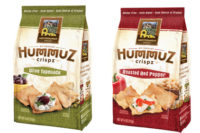Choco-Box
There’s room for more than just writing utensils in this pencil caddy: Wolfgang Candy Co., York, Pa., packages its tasty milk chocolate covered animal crackers - which are certified kosher - in a handy 7-oz. “school box” that features the alphabet for kids learning to spell. The box is adorned with phonetic pictures of a “hip-po-pot-a-mus,” “rab-bit” and “tur-tle,” among other art. Each package contains seven servings of four pieces each, for a total of 6 g. of fat and 130 calories per serving.For more information, visitwww.WolfgangCandy.com
Don't Worry, Be Happy
It’s not just parents who worry about the well-being of their children. A recent study of 1,154 kids ages 9 to 13 by KidsPoll, The Voice of America’s Children, reveals that preteens are preoccupied with the usual - their looks, schoolwork and fitting in. But above all else, these same kids worry most about “the health of someone you love.” In fact, the majority, or 86%, said they worry “almost all the time” or “a lot” about just this.According to D’Arcy Lyness, a medical editor for KidsHealth.org, “Health is on kids’ minds during the preteen years, when many schools address the dangers of smoking, drinking alcohol, unhealthy eating and not wearing seatbelts.
“At this age, kids become more aware of health problems that parents or grandparents may have,” she adds.
KidsHealth suggests that loved ones manage such worry by taking the lead with children and watching what they say around them, as well as providing information, reassurring kids, and being a good listener and role model - this includes behaviors such as eating healthy around preteens who look to adults for guidance.
For more kids’ health news, visitwww.KidsHealth.com.
Nothing But the Tooth
If you’re gonna snack, you gotta brush and floss. Just ask the American Academy of Pediatrics. The AAP and Oral-B Stages have teamed up with TV personality, best-selling author and mother of seven Joan Lunden to reinforce this message in a campaign to raise awareness of children’s oral health.Why? Case in point: A 2007 report from the Centers for Disease Control and Prevention shows that the prevalence of cavities in children ages two to five years has increased 4% from a decade ago, from 24% to 28%. In addition, nearly 20% of children ages two to three have at least one untreated cavity. According to the AAP, tooth decay is “the most common chronic childhood disease today, five times more common than asthma.” The U.S. Surgeon General and Congress concur, calling this a “silent epidemic” that needs to be addressed by parents and health care providers.
The best ways to combat this issue are through good oral health practices such as visiting the dentist regularly, brushing and flossing with the right tools, and, of course, eating healthy.
“Proper nutrition is important to your child’s oral health,” AAP notes in a release. Foods high in sugars and starches help decay-causing bacteria make acid that destroys teeth.”
For more information on this subject, visitwww.AAP.org

